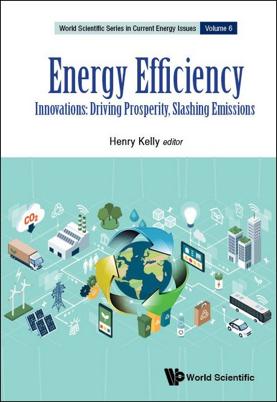New edited volume shows the intimate link between energy efficiency and the technologies that will drive tomorrow’s economic growth

Credit: World Scientific
Strategies for increasing the efficiency of energy use lie at the core of climate policy. And yet, “[i]n spite of decades of investment, enormous new opportunities in energy efficiency remain to be exploited,” says Henry Kelly, the volume’s editor and a non-resident Senior Fellow at Boston University’s Center for Sustainable Energy.
Energy Efficiency: Innovations: Driving Prosperity, Slashing Emissions provides a fresh review of the state-of-the art in energy efficiency, and shows how future investment will be intimately linked to the innovations in information technology, systems biology, material science, and other fields that will be the key drivers of our future economy.
Themes explored throughout the volume include the efficiency of systems (new vehicle technologies linked to mobility solutions made possible by information technologies, building technologies carefully integrated with sunlight, and other features of the environment, industrial technology linked to efficient use of materials and recycling, and urban systems); electrification and potentially the use of hydrogen, particularly in areas where carbon capture is impractical; and the role of information technology in creating new opportunities in the design and production of materials and devices (including biological production), and in the operation of complex systems.
With contributions from renown experts and authorities such as the Lawrence Berkeley Laboratory, NASA, Boeing, Georgia Tech and the Netherlands Environmental Assessment Agency, the work includes chapters covering: new directions in buildings and building systems; novel production systems, electrification, hydrogen, synthetic biology, and other innovations that can lead to efficiency gains in in industry; the extraordinary improvements to mobility that can be achieved through new business models for sharing, enhanced by electrification and the potential of automated vehicles; the efficiencies in aviation that can be achieved through aircraft design, routing optimization, clean fuels, and other measures; how new approaches to urban design can drive efficiencies throughout the urban areas that most of us now inhabit; and a review and analysis of international studies exploring the potential impact of energy efficiency technologies.
Says Henry Kelly, “We are not close to the theoretical limits–particularly when we look at the potential efficiency of integrated systems. I hope that this volume can spark interest of creative people in the many different fields that will be key to capturing the potential.”
Energy Efficiency: Innovations: Driving Prosperity, Slashing Emissions retails for US$108 / £95 (hardcover) and is also available in electronic formats. To order or know more about the book, visit http://www.
###
About the Editor
Henry Kelly is a Non-resident Senior Fellow at Boston University’s Center for Sustainable Energy. He has held a number of positions in the federal government including Principle Deputy Assistant Secretary and later acting Assistant Secretary for Energy Efficiency and Renewable Energy in the US Department of Energy; Associate Director for Technology, and Principal Assistant Director for Environment and Energy and Senior Advisor to the Director for the White House Office of Science and Technology Policy; Senior Associate and Program Manager at the Congressional Office of Technology Assessment, and a scientist on the strategic arms limitation staff of the US Arms Control and Disarmament Agency. He has also served as the Assistant Director of the Solar Energy Research Institute (now the National Renewable Energy Laboratory), and President of the Federation of American Scientists. He is an elected fellow of the American Association for the Advancement of Science (AAAS) and the American Physical Society, and is a member of the Advisory Board for the Energy and Environment Directorate of the Pacific Northwest National Laboratory. He has a PhD in physics from Harvard University and a BA in physics from Cornell University.
About World Scientific Publishing Co.
World Scientific Publishing is a leading international independent publisher of books and journals for the scholarly, research and professional communities. World Scientific collaborates with prestigious organisations like the Nobel Foundation and US National Academies Press to bring high quality academic and professional content to researchers and academics worldwide. The company publishes about 600 books and over 140 journals in various fields annually. To find out more about World Scientific, please visit http://www.
For more information, contact Amanda at [email protected].
Media Contact
Amanda Yun
[email protected]
Original Source
https:/




